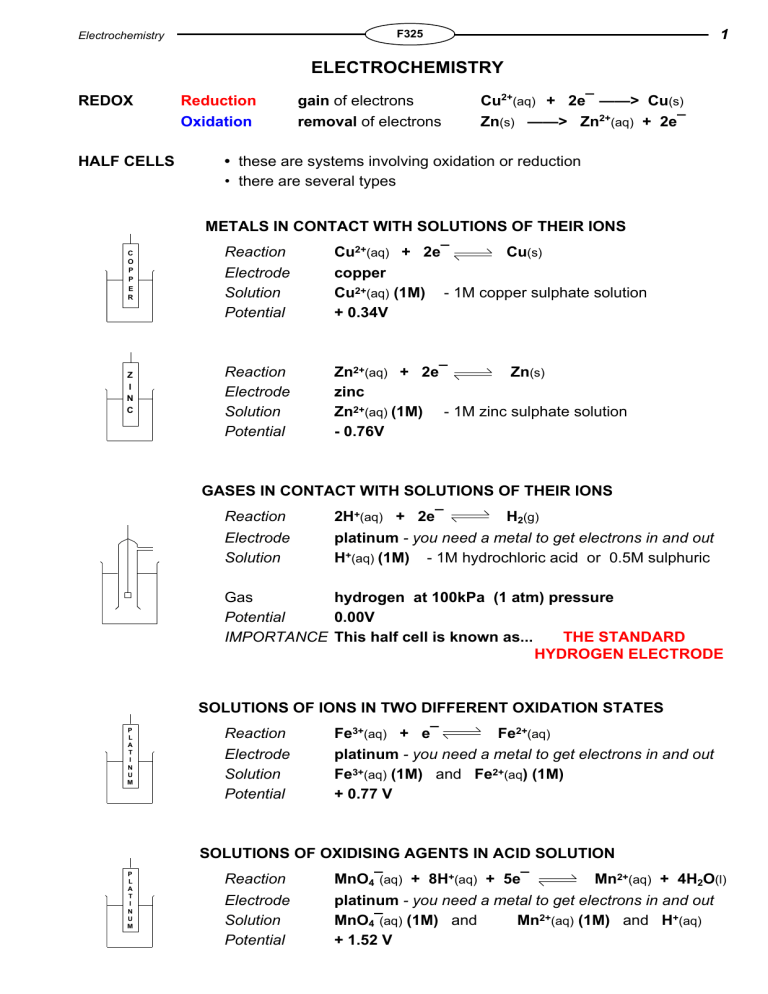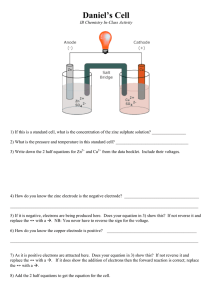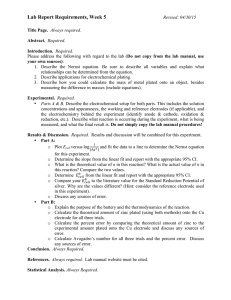
1 F325 Electrochemistry ELECTROCHEMISTRY REDOX HALF CELLS Reduction Oxidation gain of electrons removal of electrons Cu2+(aq) + 2e¯ ——> Cu(s) Zn(s) ——> Zn2+(aq) + 2e¯ • these are systems involving oxidation or reduction • there are several types METALS IN CONTACT WITH SOLUTIONS OF THEIR IONS C O P P E R Z I N C Reaction Electrode Solution Potential Cu2+(aq) + 2e¯ Cu(s) copper Cu2+(aq) (1M) - 1M copper sulphate solution + 0.34V Reaction Electrode Solution Potential Zn2+(aq) + 2e¯ Zn(s) zinc Zn2+(aq) (1M) - 1M zinc sulphate solution - 0.76V GASES IN CONTACT WITH SOLUTIONS OF THEIR IONS Reaction Electrode Solution 2H+(aq) + 2e¯ H2(g) platinum - you need a metal to get electrons in and out H+(aq) (1M) - 1M hydrochloric acid or 0.5M sulphuric acid Gas hydrogen at 100kPa (1 atm) pressure Potential 0.00V IMPORTANCE This half cell is known as... THE STANDARD HYDROGEN ELECTRODE SOLUTIONS OF IONS IN TWO DIFFERENT OXIDATION STATES P L A T I N U M Reaction Electrode Solution Potential Fe3+(aq) + e¯ Fe2+(aq) platinum - you need a metal to get electrons in and out Fe3+(aq) (1M) and Fe2+(aq) (1M) + 0.77 V SOLUTIONS OF OXIDISING AGENTS IN ACID SOLUTION P L A T I N U M Reaction Electrode Solution Potential MnO4¯(aq) + 8H+(aq) + 5e¯ Mn2+(aq) + 4H2O(l) platinum - you need a metal to get electrons in and out MnO4¯(aq) (1M) and Mn2+(aq) (1M) and H+(aq) + 1.52 V © KNOCKHARDY PUBLISHING 2008 2 F325 Electrochemistry CELL POTENTIAL • each electrode / electrolyte combination has its own half-reaction Measurement • it is impossible to measure the potential of a single electrode BUT... • you can measure the potential difference between two electrodes • value is measured relative to a refernce cell under standard conditions STANDARD ELECTRODE POTENTIAL The potential difference of a cell when the electrode is connected to the standard hydrogen electrode under standard conditions The value is affected by ... • temperature • pressure of any gases • solution concentration The ultimate reference is the STANDARD HYDROGEN ELECTRODE. CONDITIONS Hydrogen (100 kPa) Platinum temperature 298K solution conc 1 mol dm-3 with respect to H+ hydrogen 100 kPa (1 atm) pressure WHY USE PLATINUM? - you need an inert metal to get the electrons in / out Standard hydrogen electrode E° = 0.00V H +(aq) (1M) However, as it is difficult to set up, secondary standards are used. Secondary standards Calomel The standard hydrogen electrode (SHE) is hard to set up so it is easier to use a more convenient secondary standard which has been calibrated against the SHE. • the calomel electrode contains Hg2Cl2 • it has a standard electrode potential of +0.27V • is used as the left hand electrode to determine the potential of an unknown • to obtain the E° value of the unknown cell ADD 0.27V to the measured potential © KNOCKHARDY PUBLISHING 2008 3 F325 Electrochemistry Experimental determination of E° In the diagram below the standard hydrogen electrode is shown coupled up to a zinc half cell. The voltmeter reading gives the standard electrode potential of the zinc cell. V Salt Bridge (KCl) Hydrogen (100 kPa) Platinum Zinc Zn 2+ (1M) (aq) salt bridge H +(aq) (1M) • filled with saturated potassium chloride solution • enables the circuit to be completed THE ELECTROCHEMICAL SERIES Layout Species are arranged in order of their standard electrode potentials to get a series that tells us how good a species is (as an oxidising agent) at picking up electrons. All equations are written as reduction processes ... i.e. gaining electrons e.g. Al3+(aq) + 3e¯ Cl2(g) + 2e¯ Al(s) 2Cl¯(aq) E° = -1.66V E° = +1.36V The species with the more positive potential (E° value) will oxidise one (i.e. reverse the equation) with a lower E° value. Example What will happen if an Sn(s) /Sn2+(aq) cell and a Cu(s) Cu2+(aq) cell are connected? • Write out the appropriate equations Cu2+(aq) + 2e¯ Cu(s) ; E° = +0.34V Sn2+(aq) + 2e¯ Sn(s) ; E° = -0.14V • the half reaction with the more positive E° value is more likely to work • it gets the electrons by reversing the half reaction with the lower E° value • therefore Cu2+(aq) ——> Cu(s) • the overall reaction is and Cu2+(aq) Sn(s) + Sn(s) ——> ——> Sn2+(aq) Sn2+(aq) + Cu(s) • the cell voltage is the difference in E° values ... (+0.34) - (-0.14) = + 0.48V © KNOCKHARDY PUBLISHING 2008 4 F325 Electrochemistry THE ELECTROCHEMICAL SERIES E° / V F2(g) + 2e¯ 2F¯(aq +2.87 H2O2(aq) + 2H+(aq) + 2e¯ 2H2O(l) +1.77 MnO4¯(aq) + 8H+(aq) + 5e¯ Mn2+(aq) + 4H2O(l) +1.52 PbO2(s) + 4H+(aq) + 2e¯ Pb2+(aq) + 2H2O(l) +1.47 4+ Ce (aq) + e¯ (aq) +1.45 2Cl¯(aq) +1.36 3+ 2Cr (aq) + 7H2O(l) +1.33 MnO2(s) + 4H (aq) + 2e¯ Mn2+(aq) +1.23 Br2(l) + 2e¯ 2Br¯(aq) +1.07 Ag (aq) + e¯ Ag(s) +0.80 Fe3+(aq) + e¯ Fe2+(aq) +0.77 2H+(aq) + 2e¯ H2O2(l) +0.68 I2(s) + 2e¯ 2I¯(aq) +0.54 Cu+(aq) + e¯ Cu(s) +0.52 Cu2+(aq) + 2e¯ Cu(s) +0.34 Cu2+(aq) + e¯ Cu+(aq) +0.15 Sn4+(aq) + 2e¯ 2+ Sn (aq) +0.15 2H+(aq) + 2e¯ H2(g) 0.00 Pb2+(aq) + 2e¯ Pb(s) -0.13 Sn2+(aq) + 2e¯ Sn(s) -0.14 Ni2+(aq) + 2e¯ Ni(s) -0.25 Cr3+(aq) + e¯ Cr2+(aq) -0.41 Fe2+(aq) + 2e¯ Fe(s) -0.44 (aq) + 2e¯ Zn(s) -0.76 Al3+(aq) + 3e¯ Al(s) -1.66 Mg2+(aq) + 2e¯ Mg(s) -2.38 Na+(aq) + e¯ Na(s) -2.71 Ca2+(aq) + 2e¯ Ca(s) -2.87 K(s) -2.92 Cl2(g) + 2e¯ Cr2O72-(aq) + I4H+(aq) + 6e¯ + + O2(g) + Zn + 2+ K (aq) + e¯ Interpretation Use of E° Ce 3+ + 2H2O(l) reaction is more likely to go right LH species better oxidising agents RH species weaker reducing agents RH species are harder to oxidise LH species are easier to reduce reactivity of metals decreases reactivity of non-metals increases F2 is the best oxidising agent - highest E° value; most feasible reaction K+ is the worst oxidising agent - lowest E° value; least feasible reaction K is the best reducing agent - most feasible reverse reaction • used to predict the feasibility (likelihood) of redox and cell reactions • in theory ANY REDOX REACTION WITH A POSITIVE E° VALUE WILL WORK • in practice, it will proceed if the E° value is greater than + 0.40V An equation with a more positive E° value will reverse a less positive one. © KNOCKHARDY PUBLISHING 2008 5 F325 Electrochemistry Combining half-cells In the cell, copper has a more positive E° value (+0.34V) than zinc (-0.76V). • the zinc metal is more reactive V − • it dissolves to give ions Zn(s) —> Zn2+(aq) + 2e¯ • the electrons produced go round the external circuit to the copper Zinc Copper • electrons are picked up by copper ions and copper is deposited Cu2+(aq) + 2e¯ —> Cu(s) • The voltage of the cell is 1.10V Cell diagrams + Salt Bridge (KCl) Cu 2+ (aq) Zn 2+ (aq) ie (+0.34V) - (-0.76V) These give a diagrammatic representation of what is happening in a cell. Place the cell with the more positive E° value on the RHS of the diagram. V − ANODE Zn (s) zinc is in contact with a solution of zinc ions 2+ Zn + 2+ Cu (aq) Cu (aq) the solutions are joined by a salt bridge (s) CATHODE the solution of copper ions is in contact with copper Drawing it out as shown indicates that ... • the cell reaction goes from left to right • the electrons go round the external circuit from left to right • the cell voltage is E°(RHS) - E°(LHS). In this way it must be positive • oxidation takes place at the anode and reduction at the cathode Conclusion The reaction(s) will proceed from left to right OXidation REDuction Zn(s) Cu2+(aq) + 2e¯ ——> Zn2+(aq) + 2e¯ at the ANODE ——> Cu(s) at the CATHODE Electrons Go from the anode to the cathode via the external circuit Cell reaction Zn(s) + Cu2+(aq) ——> Cell voltage E°(RHS) - E°(LHS) = © KNOCKHARDY PUBLISHING 2008 Zn2+(aq) + Cu(s) 0.34V - (- 0.76V) = 1.10V 6 F325 Electrochemistry Example Will this reaction be spontaneous? Sn(s) + Cu2+(aq) ——> Sn2+(aq) + Cu(s) Method • Write out the half equations Cu2+(aq) + 2e¯ Cu(s) ; E° = +0.34V as reductions with their E° values Sn2+(aq) + 2e¯ Sn(s) ; E° = -0.14V • The reaction which occurs involves the more positive one reversing the other therefore Cu2+(aq) ——> Cu(s) and Sn(s) ——> Sn2+(aq) • If this is the equation you want (which it is) then it will be spontaneous • The cell voltage is the difference in E° values... (+0.34V) - (-0.14V) = + 0.48V NOTE: DOUBLING AN EQUATION DOES NOT DOUBLE THE E° VALUE Q.1 ½Cl2(g) + e¯ Cl¯(aq) E° = + 1.36V Cl2(g) + 2e¯ 2Cl¯(aq) E° = + 1.36V Which of the following reactions occur spontaneously ? • • • • • • Fe(s) + Zn2+(aq) Sn4+(aq) + 2Fe2+(aq) Sn4+(aq) + 2I¯(aq) Cl2(g) + 2Br¯(aq) I2(g) + 2Br¯(aq) 2H+(aq) + Zn(s) ——> ——> ——> ——> ——> ——> Fe2+(aq) + Zn(s) 2Fe3+(aq) + Sn2+(aq) I2(s) + Sn2+(aq) Br2(g) + 2Cl¯(aq) Br2(g) + 2I¯(aq) H2(s) + Zn2+(aq) For those that work, calculate the cell voltage. IMPORTANT WARNING Limitation of using E° to predict the feasibility of a reaction Kinetic Standard electrode potentials are not always accurate in their predictions. They indicate if a reaction is possible but cannot say what the rate will be. Some reactions will not be effective as they are too slow. Conditions Because TEMPERATURE and CONCENTRATION affect the value of a standard electrode potential any variation can also affect the probability of a reaction taking place. Concentrations do change during a reaction. Apply le Chatelier’s principle to predict the change in E° © KNOCKHARDY PUBLISHING 2008 7 F325 Electrochemistry Q.2 Explain what reactions, if any, will occur if aqueous solutions of KCl, KBr and KI are treated with; a) acidified KMnO4 b) acidified K2Cr2O7 . Q.3 Using E° values, explain why zinc reacts with dilute acids to produce hydrogen gas but silver doesn’t .Q.4 Construct a cell diagram for a cell made up from Ni2+/Ni and Zn2+/Zn. Work out the overall reaction and calculate the potential difference of the cell. Q.5 Why is hydrochloric acid not used to acidify potassium manganate(VII) ? Q.6 Explain why the chemistry of copper(I) in aqueous solution is limited. The following half equations will help. Name the overall process which takes place. Cu+(aq) + e¯ Cu(s) E° = + 0.52V Cu2+(aq) + e¯ Cu+(aq) E° = + 0.15V © KNOCKHARDY PUBLISHING 2008





